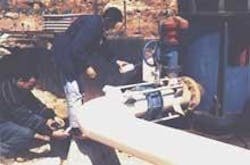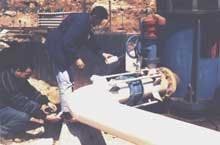Shared aquifer management in West Bank requires political courage
By David J. Scarpa
Engineers and scientists have been warning political authorities of the current overexploitation of West Bank aquifers, but the 16 new water wells drilled into the already depleted Eastern Aquifer are threatening its sustainability. Wise aquifer management shared between Israeli and Palestinian authorities could possibly save the aquifer in the foreseeable future.
Palestinians consume only 82 m3/cap/yr of which 26 m3 is for domestic consumption. Globally, average water consumption is 800 m3 per capita/year; Israeli settlers in the West Bank consume this amount, ten times more than Palestinians.
Shared management has been studied in detail by Israeli and Palestinian academic and professional scientists, but politicians on both sides are reluctant to publicly endorse their recommendations. Joint workshops organised by the Truman Institute of the Hebrew University of Jerusalem and the Palestinian Consultancy Group have taken place since 1994, shortly after the start of the Peace Process. Unfortunately, time is running out — most of the shared aquifers will only be able to supply water for domestic consumption for less than 25 years.
The Palestinian Water Authority could provide considerably more water for the Palestinian population since implementation of Article 40 of the Interim Accords (1995). Political leaders, foreign donors and local non-government organizations have drilled more water wells in order to alleviate the severe water stress suffered by Palestinians for many years.
The southern West Bank receives most of its domestic water from an aquifer contained within the eastern limb of the anticlinal structure that forms the Hebron Mountains, which is referred to as the Eastern Aquifer in the Bilateral Interim Accords (1995). Overexploitation endangers this supply. The six wells drilled after 1967 by the Israeli Mekorot Company have been lowering the static water table at an average rate of about three metres per year since the mid-1970s. The Bilateral Interim Agreement (1995) allowed further exploitation to satisfy the domestic needs of Palestinian populations in the Hebron and Bethlehem districts. The responsibility to provide adequate water supplies to the Palestinian communities prompted the Palestinian National Authority to embark on a policy of aquifer extraction that further endangers the sustainability of an already vulnerable resource. Foreign funding agencies and drilling companies are doing nothing to discourage this policy. Politicians, foreign donors and local non-government organizations are primarily concerned with alleviating the severe water stress suffered for so long by the Palestinian population.
The rapid response of the aquifer to the very high rainfall of the 1991 to 1992 season encouraged the Israeli authorities to increase extraction rates from the Mountain Aquifer. However, subsequent low rainfall for the remainder of the decade in addition to over-pumping seriously lowered the static water table. Once the 16 new wells begin full production, the interference between so many wells in such a relatively small well field may result in a massive combined draw-down in the Herodion field, according to A. Aliewi and A. Jarrar in a report for the Palestinian Water Authority (PWA) in Ramallah.
Severe travel restrictions imposed by the Israeli army of occupation since the autumn of 2000 have held up necessary construction and maintenance equipment required for the management and distribution infrastructure of the new wells. Only two of the 16 new wells were actually pumping at the end of October 2002, reported M. Al-Wahsh, the chief engineer in charge of PWA wells.
Another cause for concern is contamination by faecal coliform bacteria. Water extracted from some of the wells is contaminated with the bacteria. No sewage treatment plant operates in the southern West Bank and the karstic nature of the surface and subsurface geology facilitates rapid infiltration of polluted water. Plans for a wastewater treatment plant to the south of Hebron have been held up because of the current volatile situation. Treated wastewater must be regarded as a valuable resource, necessary to augment dwindling water supplies and protect the aquifer from contamination.
Politicians, scientists and other interested parties could reach a managerial solution to improve water availability for the Palestinian population in the southern West Bank; however this resolution requires courageous political decisions that run counter to popular cultural expectations.
Author's noteDavid J. Scarpa is chief scientist in the Water and Soil Environmental Research Unit at Bethlehem University. For more information, contact the author at Email: [email protected]

